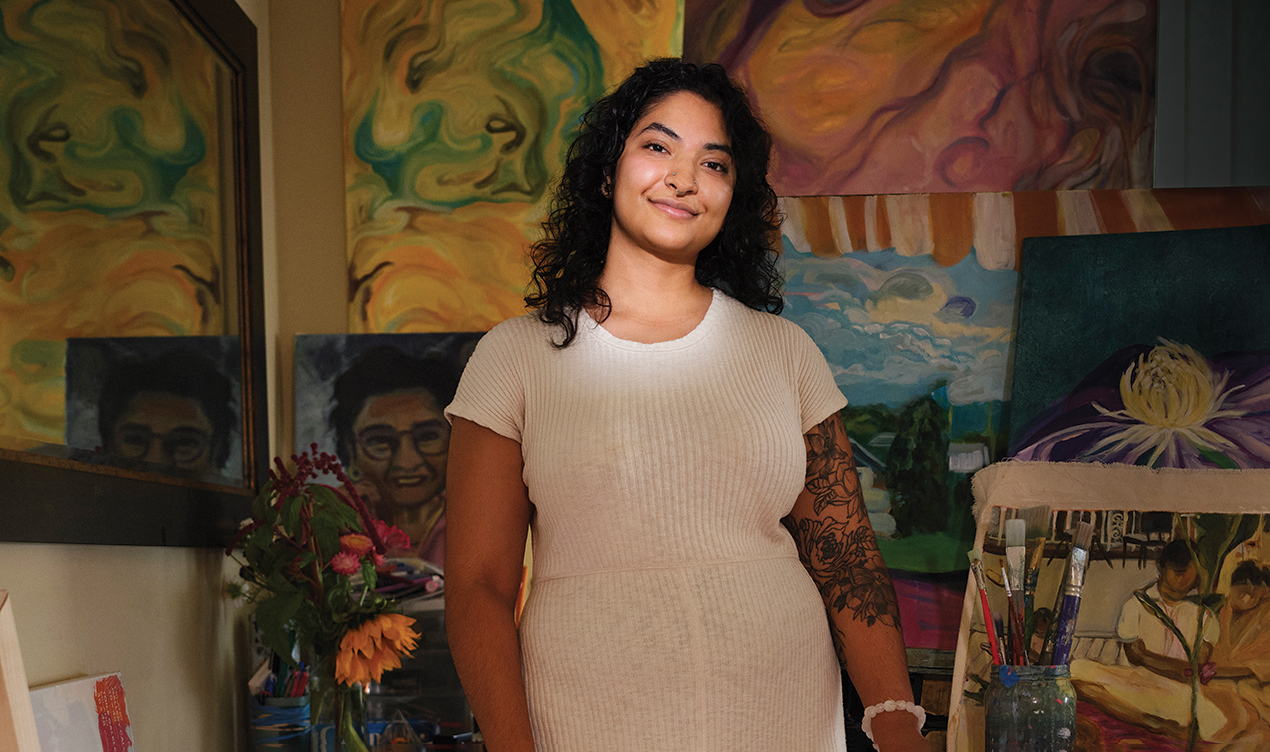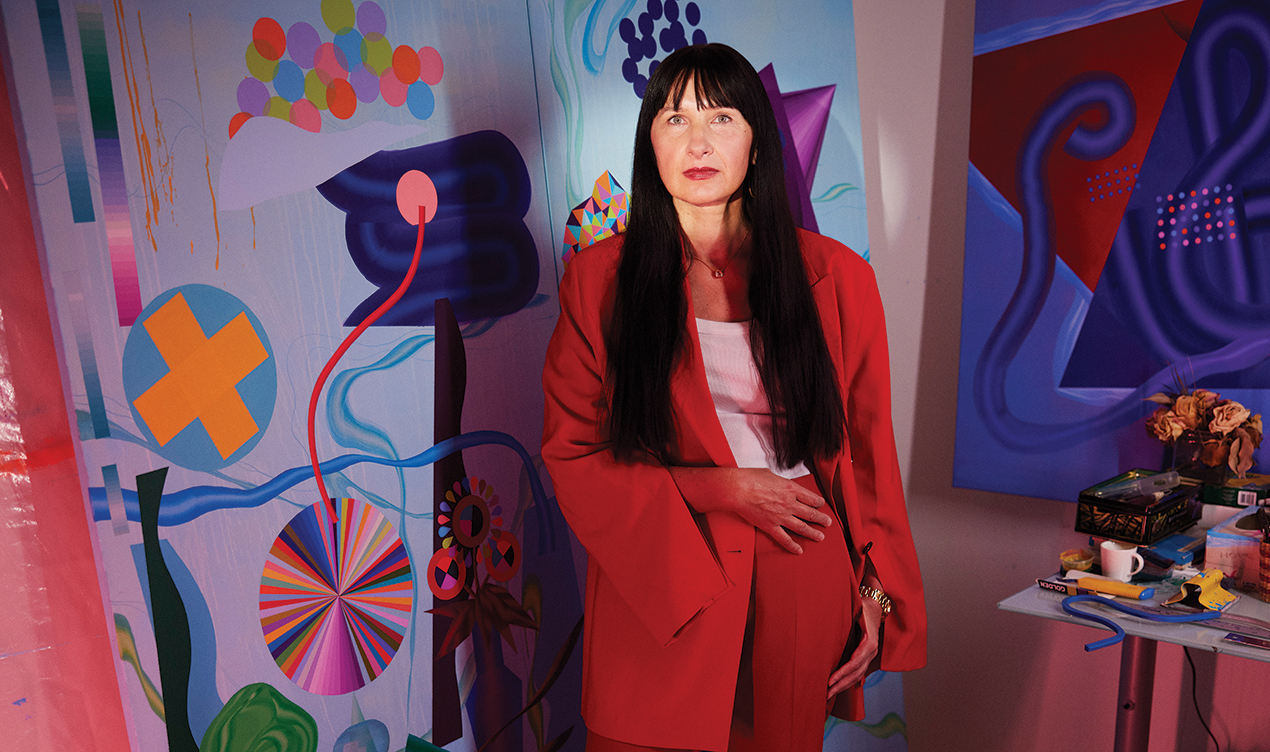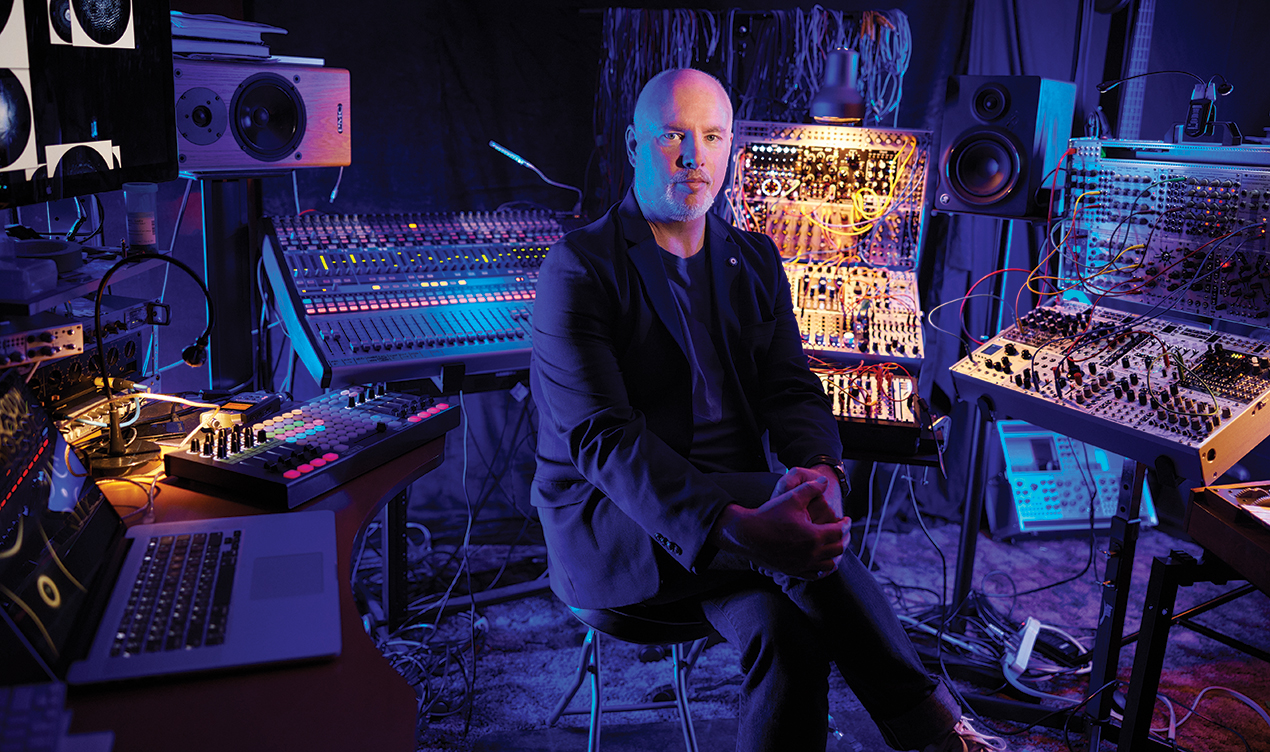
Once expressed, the messages received depend on your interpretation — and the paths from inspiration to final works are not always clear to the artists themselves. Bringing modern perspectives to old forms, these artists can’t help but create, and we can’t help but share their stories. Read on to find out what makes these people make the things we love.
When you ask artist and painter Kira Chankasingh about the biggest design lessons she learned at art school, unsurprisingly, it comes down to the details. One particular instance that sticks out occurred while Chinkasingh was attending the illustrious Emily Carr University of Art + Design in Vancouver, having transferred there from the Alberta College of Art and Design (“I initially wanted to go to MacEwan,” she laughs, “But once they physically saw my work they were like, nah.”). While making line drawings on paper, her instructor passed by and asked why she wasn’t experimenting with different line weights. Chankasingh gestured to the three pencils she had in front of her. As she soon found out, that wasn’t going to cut it.
“She just took the pastel and turned it on its side,” Chinkasingh says, remembering that fleeting, but revolutionary, act. “Something as minuscule as that stuck with me for so long because I was like, ‘wow, this is why I’m here, for something as small as that.’ It took me so long to just turn it on its side.”
Chankasingh moved back to Edmonton after graduating from Emily Carr, but those lessons of simple subversion are still just as evident in her art. In her portraits, Chankasingh paints blurry-faced vignettes made from mashups of treasured family pictures. The result is simultaneously eerie and warm, fact and fiction, the paintings straddling a runny middle ground between concrete photographic record and fading collective memory. A mashup of identities herself — she has Trinidadian and Tobagonian roots, was born in Yellowknife and split her childhood between the Northwest Territories and Edmonton — Chankasingh’s art navigates those feelings of place and placelessness.

“My style is getting to know myself. My style is leaving an impression and creating a memory that is not necessarily your own, but you can still relate to it. It’s like an absent memory,” Chankasingh says. “And that has a lot to do with my identity as well because my being so far away from what my parents call ‘home’ is really different, because they still talk so highly about home and being home but they’re also proud to be Canadian.“
Beyond expressing herself as an artist, Chankasingh is also firmly grounded in the discipline of art. Whether that means making sure she always has a sketchbook on hand to record a runaway idea, learning the business of art or downsizing her paintings to accommodate customers’ (very real) square footage concerns, Chankasingh applies the lessons she’s learned from art school, as well the school of life. The most important lesson of all, though, is one that both transcends and marks her work.
“It goes back to community and finding your community,” Chikasingh says, reflecting on the connections she’s made from Trinidad and Tobago, the Northwest Territories, Edmonton — and everywhere in between. “Once you’re with people who are able to support you, you have more freedom to do the things that you want to do and you don’t care if you make something bad. It takes the pressure off of making mistakes.” — Tom Ndezeki
I’m sitting in Oksana Movchan’s living room, where art made by her, her late father, her sister and her partner, Gary James Joynes, adorn the walls. It’s a living gallery that tells the story of her life and the people she loves. Movchan herself is a vision of vibrancy in a striking blazer, a reflection of the phase of life she’s currently embracing — one of brightness and renewal, much like her latest paintings.
Movchan’s life reads like a tapestry woven with threads of both brilliance and sorrow, each stitch carrying the weight of memories, revealing a masterpiece of resilience. Born and raised in Ukraine, in a family of artists, she was destined for a life imbued with creativity. “Kids play with toys, and we played with all my father’s art materials and painting brushes,” she says with a laugh.

Movchan attended a specialized art school from Grade 5, after which she was accepted into the Ukrainian National Academy of Arts, where she eventually graduated with a PhD in printmaking. She was then offered a position as an associate professor at the academy when she was just 27, an opportunity that came on the heels of her rapid success as an artist. At that time, though, she didn’t feel ready to take on the role. “I felt like I had so much more to learn, so much more to experience,” she recalls.
After making a name for herself in her homeland, she was invited to Toronto for a solo show at the Canadian-Ukrainian Art Foundation in 1996. It was a turning point — not just in her career, but in her life. “One thing led to another, and then I’m like, ‘I guess I’m living here now,” says Movchan. “You could say I was brave, you can say irresponsible, you can say adventurous, I’m not even sure which one it was.”
Yet, as she reflects on her journey, Movchan carries no bitterness, no lingering “what ifs” — just a quiet, resolute acceptance. She repeatedly says she has no regrets, a phrase that becomes a mantra as she recounts the years of her life, both the triumphs and the trials.
“The change in my art is probably even invisible, it more so happened in the way I switched mediums,” she says. “I was a printmaker. Then I worked on glass. And then I have my etching technique on gold, silver. And then when I started painting that was a big change.”
Movchan describes her style as “abstract storytelling,” because “real art, I think, happens when artists can find that beautiful, very fine balance between analytical process and… intuition or inspiration or magic, or whatever you label it.”
Now, decades later, Oksana has returned to academia, teaching painting at the University of Alberta. “Teaching is a way of giving back, of passing on what I’ve learned through all these years,” she says.
She shows me her studio along with a few unfinished paintings — nine, to be exact. But they are all a far cry from the heavy, monochromatic pieces of her last few collections. They are bright and happy. Movchan describes this shift yet again as “natural,” where she allowed herself to trust her instincts and embrace the full spectrum of her creative potential.
Movchan, still in her bright blazer, radiates the same energy as the art around her. It’s a moment that captures her essence perfectly — a woman who, despite the many challenges she’s faced, continues to live with no regrets, letting her instincts guide her to where she needs to be. — Hiba Zaidi
Five minutes into my conversation with artist Gary James Joynes, I realize brushing up on my high-school physics would have been a good idea. Joynes, a visual/sound artist, integrates complex scientific concepts with his innovative artistic vision. His home, shared with partner Oksana Movchan and their fluffy feline companion, Kishka (which means “cat” in Ukrainian), is a haven of creativity and curiosity.
“A lot of people would know me when I was younger more for my music,” Joynes reflects, acknowledging his early career in metal bands where he was a lead singer and bassist. Yet, his passion for visual art, honed through years as an art director and graphic designer, was always simmering beneath the surface.
In his early 30s, Joynes pivoted from heavy metal to ambient and experimental music. “I immediately started working with the idea of putting visuals to the sound experiments that I was doing,” he explains. This led to his groundbreaking audio-visual performance project, Clinker, which premiered at the MUTEK Festival in Montreal in 2003 and garnered significant attention (Clinker has also become his stage name).
The buzz around Clinker caught the eye of the Banff Centre for the Arts, where Joynes was invited to perform at the New Media Summit in 2007. This pivotal moment opened doors to further exploration and innovation. “In 2009, I saw a film by Swiss scientist Hans Jenny showing the visualization of sound through particles,” Joynes recounts, which inspired his development of the Wave Driver, a modern take on Chladni plates (named after German scientist and musician Ernst Chladni) that vibrates sound particles to reveal their wave shapes.
His approach earned him the Foot Award in 2016 for his piece, Broken Sound. “The installation was a reflection on the life cycle of sound through speakers,” Joynes explains. “Metaphorically, we start as these perfectly gold, unscarred beings, and as life progresses, we age and scar until the wire breaks, symbolizing death.”
Joynes describes his art as a blend of visual and auditory elements, emphasizing the concept of synchresis, a term coined by French film theorist Michel Chion.
“It’s when our brains make a connection between what we hear and what we see, even if we’re not physically seeing it.” — Hiba Zaidi
This article appears in the October 2024 issue of Edify








